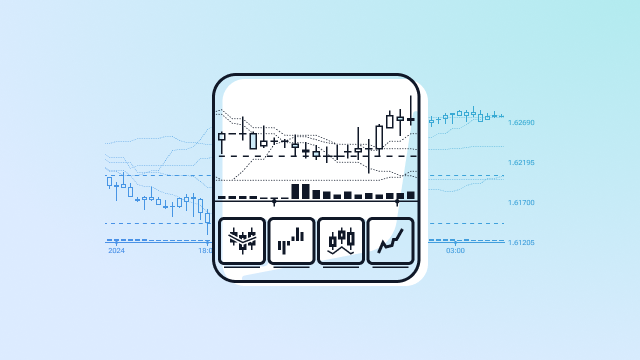Technical analysis is key in trading, and the Aroon indicator is a top tool. It helps find trends and when they might change. This makes it a favorite among traders.
The Aroon indicator looks at the time between highs and lows. It shows the trend’s strength and direction. This helps traders make smart choices, finding good opportunities and avoiding bad ones.
Learning to use the Aroon indicator boosts a trader’s market confidence. It’s a powerful tool for navigating the markets.
Key Takeaways
- Understanding the Aroon indicator’s role in technical analysis.
- Identifying trends using the Aroon indicator.
- Using the Aroon indicator to spot potential trend reversals.
- Making informed trading decisions with the Aroon indicator.
- Enhancing trading confidence through effective trend identification.
Understanding the Aroon Indicator
Chart analysis often uses many indicators, with the Aroon indicator being key for spotting trends. It’s a tool for technical analysis that shows trend strength and direction. It does this by looking at the time since the highest high and lowest low over a set period.
Origin and Development
Tushar Chande developed the Aroon indicator in 1996. Chande, a famous technical analyst, made it to measure trend strength by looking at high and low times. It’s great for seeing if a market is trending or just moving sideways.
Basic Components: Aroon Up and Aroon Down
The Aroon indicator has two main parts: Aroon Up and Aroon Down. Aroon Up shows how long it’s been since the last high. Aroon Down shows how long it’s been since the last low. Together, they help analyze trends and find trading chances.
| Component | Description | Function |
|---|---|---|
| Aroon Up | Measures time since last highest high | Identifies upward trend strength |
| Aroon Down | Measures time since last lowest low | Identifies downward trend strength |
By looking at Aroon Up and Aroon Down, traders can understand the market’s trend direction and strength. This helps them make better trading choices.
How the Aroon Indicator Works
To grasp the Aroon indicator’s function, we must explore its mathematical basis and its role in trading. It’s a tool for technical analysis that shows trend strength by looking at time since the last high or low.
The Mathematical Formula
The Aroon indicator’s formula is simple. It has two parts: Aroon Up and Aroon Down. Aroon Up is ((Number of periods – Number of periods since highest high) / Number of periods) * 100. Aroon Down is ((Number of periods – Number of periods since lowest low) / Number of periods) * 100. These formulas give a percentage showing trend strength.
Calculating Aroon Values
To find Aroon values, traders look at the time since the last high and low. They use a 25-period Aroon indicator as a standard. This helps understand the trend’s direction and power.
Setting Up the Aroon Indicator on Your Charts
To add the Aroon indicator to charts, pick it from your platform’s list. It’s usually under technical indicators. Adjust the period, often set to 25 by default. Then, watch the Aroon Up and Down lines for trend analysis and trading signals.
Interpreting the Aroon Indicator Signals
Understanding the Aroon indicator’s signals is key for smart trading. It shows the strength and direction of market trends. This helps traders spot good opportunities.
Understanding Aroon Up and Aroon Down Movements
The Aroon Up and Aroon Down lines are the heart of the Aroon indicator. If Aroon Up is higher, it means the market is going up. On the other hand, if Aroon Down is higher, it means the market is going down. This is important for spotting trends.
Identifying Strong Trends
A strong trend is shown when either line is near 100. For example, if Aroon Up is near 100 and way above Aroon Down, it’s a strong uptrend. Traders can use this to make the most of their trades.
Recognizing Consolidation Periods
When both lines are low and close, it’s a consolidation period. The market isn’t moving strongly in either direction. Traders need to adjust their plans for these times. Knowing these periods helps in adapting to market changes.
Using the Aroon Indicator to Spot Trend Reversals
Traders can use the Aroon indicator to spot trend changes. This tool is great for catching early signs of trend reversals. It helps traders adjust their strategies quickly to market changes.
Early Warning Signs of Trend Changes
The Aroon indicator watches the Aroon Up and Aroon Down lines. If the Aroon Up line drops below the Aroon Down line, a downtrend might start. On the other hand, if the Aroon Up line goes above the Aroon Down line, an uptrend could begin.
Some important signs to watch for are:
- Aroon Up and Aroon Down crossovers
- Changes in the Aroon indicator’s slope
- Extreme values in the Aroon indicator (above 80 or below 20)
Confirmation Signals
While the Aroon indicator is helpful, it’s crucial to look for confirmation. Other technical indicators, like moving averages or the relative strength index (RSI), can help confirm the Aroon indicator’s signals.
| Confirmation Signal | Description | Validation |
|---|---|---|
| Moving Average Crossover | Short-term MA crosses above/below long-term MA | Confirms trend change |
| RSI Extreme Values | RSI above 70 or below 30 | Supports Aroon indicator's signal |
| Volume Analysis | Increasing volume with trend change | Validates trend reversal |
Trading Strategies with the Aroon Indicator
Trading strategies often use tools like the Aroon indicator for technical analysis. Understanding the Aroon indicator helps traders create strong plans. These plans help them deal with different market situations.
Trend-Following Strategy
A trend-following strategy with the Aroon indicator looks for strong trends. If Aroon Up is over 70 and Aroon Down is under 30, it’s a good time to buy. On the other hand, if Aroon Down is over 70 and Aroon Up is under 30, it’s time to sell.
Breakout Strategy
The Aroon indicator can also spot potential breakouts. When both Aroon Up and Aroon Down are low (under 30), it might mean a consolidation phase. If Aroon Up starts to rise and goes above Aroon Down, it could mean an uptrend breakout.
Combining Aroon with Other Indicators
Traders often mix the Aroon indicator with other technical tools. For example, using it with moving averages or the Relative Strength Index (RSI) gives a better view of trends. This makes trading signals more accurate.
Step-by-Step Guide to Trading with the Aroon Indicator
Trading with the Aroon indicator needs a good grasp of its signals. This guide will show you how to use it to spot entry points, set stop-loss levels, and aim for profit targets.
Identifying Entry Points
To spot entry points, watch for when the Aroon Up and Aroon Down lines cross over. A bullish crossover, where Aroon Up goes above Aroon Down, might signal a buy. On the other hand, a bearish crossover, where Aroon Down goes above Aroon Up, could mean it’s time to sell.
- Keep an eye on the Aroon Up and Aroon Down lines for crossovers.
- Also, check the overall trend and other technical indicators for extra confirmation.
Determining Stop-Loss Levels
Setting stop-loss levels is key when trading with the Aroon indicator. For long positions, place a stop-loss order below the recent swing low. For short positions, place it above the recent swing high. The Aroon indicator shows the trend’s strength, helping you find these levels.
- Find recent swing highs and lows using the Aroon indicator signals.
- Then, set stop-loss orders to cap potential losses.
Setting Profit Targets
Setting profit targets means looking at the trend’s strength shown by the Aroon indicator. For strong trends, aim for levels that are key support or resistance. Adjust these targets based on the market’s overall state.
- Use the Aroon indicator to measure the trend’s strength.
- Adjust profit targets based on key support or resistance levels.
Common Mistakes and Limitations When Using the Aroon Indicator
The Aroon indicator is useful but has its limits. Traders need to know these to use it well. It helps spot strong trends and possible reversals, but it’s not without its risks.
False Signals in Volatile Markets
In volatile markets, the Aroon indicator can send out false signals. It might keep switching between buy and sell signals. This can lead to losses if not handled carefully. It’s wise to use it with other tools to avoid these false signals.
Overreliance on a Single Indicator
Dependence on just the Aroon indicator is risky. It’s better to use several tools and indicators together. This way, you make more informed trading choices.
| Common Mistakes | Impact on Trading | Mitigation Strategy |
|---|---|---|
| Ignoring Market Volatility | False signals leading to losses | Combine Aroon with volatility indicators |
| Overreliance on Aroon Indicator | Missed opportunities or losses | Use multiple indicators for confirmation |
| Failure to Adjust Timeframes | Inaccurate signals for the trading timeframe | Adjust Aroon settings according to trading strategy |
Knowing these limits and adjusting your strategy can help you use the Aroon indicator better.
Conclusion
The Aroon indicator is a valuable tool for traders. It helps identify trends and make informed decisions. By understanding Aroon Up and Aroon Down, traders can see the strength of a trend and predict reversals.
Using the Aroon indicator well can improve decision-making and boost confidence in trading. This tool is key to making better choices in the market.
Traders can use what they learned here to get better at spotting trends. They can also develop strong trading strategies. By combining the Aroon indicator with other tools, traders can handle complex markets better.
In the end, the Aroon indicator is a powerful tool for successful trading. It gives traders the insights they need to stay ahead and make the most of new trends.
FAQ
How do I set up the Aroon indicator on my trading charts?
To add the Aroon indicator, pick it from your platform’s list, usually under “Trend” or “Momentum”. Set the period to 25, and tweak other settings as you like.
What does it mean when Aroon Up crosses above Aroon Down?
When Aroon Up goes over Aroon Down, it’s a good sign. It means an uptrend might be starting or getting stronger. This can be a buy signal or confirm an uptrend.
What is the significance of the Aroon Indicator crossing above or below the 50 level?
Crossing above 50 on Aroon-Up means a strong uptrend. Crossing above 50 on Aroon-Down means a strong downtrend. Below 50 may signal a trend weakening.
How do I adjust the Aroon Indicator settings for different markets or time frames?
Adjust the settings by changing the time period. A shorter period makes it more sensitive. A longer period gives a broader trend view.
How can I avoid false signals when using the Aroon indicator?
To avoid false signals, use the Aroon indicator with other analysis like chart patterns. Also, changing the Aroon period or using it on longer frames can help.
Is the Aroon indicator suitable for all types of trading, including day trading and swing trading?
Yes, the Aroon indicator fits different trading styles. Just adjust the period and time frame to match your strategy and goals.
 ไทย
ไทย
 Tiếng Việt
Tiếng Việt
 Polski
Polski
 Türkçe
Türkçe
 Nederlands
Nederlands
 Română
Română
 한국어
한국어
 Svenska
Svenska


